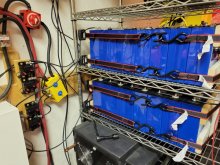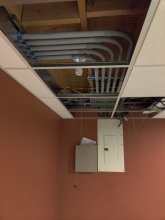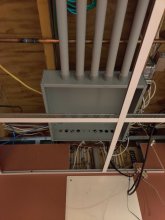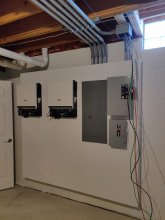You are using an out of date browser. It may not display this or other websites correctly.
You should upgrade or use an alternative browser.
You should upgrade or use an alternative browser.
MPP LV6548
- Thread starter poldim
- Start date
jasonhc73
Cat herder, and dog toy tosser.
Where are you keeping the cells?I just received my LV2724 for a work shed, and a 6548 for the house. To me its all about simplicity and value. I also just ordered 16 280ah cella for the 48V source. Anyone know of the best BMS for those Lishen cel
I don't use a bms. I use an active balancer.
I keep the batteries inside the house. I control the top and bottom with the LV6548 charge settings.
Bulk 58.4V (3.65 per cell)
Float 53.1V (3.319V per cell ~ 80% SOC
Bottom cutoff is set to 44V ( 2.75V per cell, ~ 5% SOC)
My brand new cells rest at just 3.326V (53.216 V, ~82% SOC). Trying to force them to 3.65 is a colossal waste of energy and time. The time it takes to get them from 99.5% to 100% is pretty much the same amount of time it takes to charge them from 10% to 85%. And then even if you manage to get them to 3.65V, they just return to about 3.3V anyway.
This is 10 days just sitting after being charged to 3.65V which took 4 days from 3.297V.

The more I have researched the BMS stuff, the more I feel like this is exactly the way I want to go as well for my system as well. One thing I'm still thinking about is possibly adding a Victron Smart shunt and would like to have a screen possibly mounted on the door of my battery compartment. I could also check it with the phone too.Where are you keeping the cells?
I don't use a bms. I use an active balancer.
I keep the batteries inside the house. I control the top and bottom with the LV6548 charge settings.
Bulk 58.4V (3.65 per cell)
Float 53.1V (3.319V per cell ~ 80% SOC
Bottom cutoff is set to 44V ( 2.75V per cell, ~ 5% SOC)
My brand new cells rest at just 3.326V (53.216 V, ~82% SOC). Trying to force them to 3.65 is a colossal waste of energy and time. The time it takes to get them from 99.5% to 100% is pretty much the same amount of time it takes to charge them from 10% to 85%. And then even if you manage to get them to 3.65V, they just return to about 3.3V anyway.
This is 10 days just sitting after being charged to 3.65V which took 4 days from 3.297V.
View attachment 35720
Still raking over some idea's on the DC side, but agree with the fact that I can let the LV6548's manage the high and low on the batteries while the active balancer takes care of the rest.
She's coming along. Batteries probably won't be here until early March though.
Attachments
jasonhc73
Cat herder, and dog toy tosser.
That is a beautiful setup.The more I have researched the BMS stuff, the more I feel like this is exactly the way I want to go as well for my system as well. One thing I'm still thinking about is possibly adding a Victron Smart shunt and would like to have a screen possibly mounted on the door of my battery compartment. I could also check it with the phone too.
Still raking over some idea's on the DC side, but agree with the fact that I can let the LV6548's manage the high and low on the batteries while the active balancer takes care of the rest.
She's coming along. Batteries probably won't be here until early March though.
Paint that white space with some chalkboard paint, so some chaos can be drawn.
Sanwizard
Solar Wizard
- Joined
- Feb 2, 2021
- Messages
- 2,714
Quick question. With 3.6v 280ah cells, 14 x 3.6 = 50V. The LV6548 requires 48 volts. That being the case, why are folks creating 16s strings? 3.6x16 = 57V
The question is which is better or required to power the inverter? 50 or 57 volts?
jasonhc73
Cat herder, and dog toy tosser.
280ah cells are nominal 3.2V, don't use the 100% SOC number.Quick question. With 3.6v 280ah cells, 14 x 3.6 = 50V. The LV6548 requires 48 volts. That being the case, why are folks creating 16s strings? 3.6x16 = 57V
The question is which is better or required to power the inverter? 50 or 57 volts?
The inverter works on a range of voltage. Better doesn't mean anything when you are doing incorrectly. "12V batteries" usually work best at 13.6, and get charged with 14.4, and often work fine down to 9.6V.
Keep it simple and use LiFePO4 in 16S. Other lithium chemistries work in 15S. They are not the same discharge curve or have the same nominal voltage.
I will have my LV6548 in a week. Going to stick it in an enclosed trailer and charge my tesla with it. Such a great price considering the output and features.
jasonhc73
Cat herder, and dog toy tosser.
I hope you got two. It is only 120V single phase as a single.I will have my LV6548 in a week. Going to stick it in an enclosed trailer and charge my tesla with it. Such a great price considering the output and features.
Dave (Boog)
New Member
Lishen Lifepo4 cells are 3.2 nominal not 3.6v. 16s is correct for 48v using Lifepo4.Quick question. With 3.6v 280ah cells, 14 x 3.6 = 50V. The LV6548 requires 48 volts. That being the case, why are folks creating 16s strings? 3.6x16 = 57V
The question is which is better or required to power the inverter? 50 or 57 volts?
jasonhc73
Cat herder, and dog toy tosser.
16 times 300 equals 4800.I'm new to the solar game and still trying to wrap my head around it. So two simple and perhaps stupid questions.
Can you tie 16ea 300w solar panels to a single LV6548?
Does the LV6548 charge batteries simultaneously with output flowing?
So, yes you can put them on one LV6548, PROBABLY. Put 2500 w of each panel on each of the PV inputs and it will probably work great. Most likely 4 strings of 5, 2 in parallel is the simplest way to draw it up and think about it.
The back of the panel has a label. Take a picture and post it.
Yes the charger and inverter work simultaneously.
Sanwizard
Solar Wizard
- Joined
- Feb 2, 2021
- Messages
- 2,714
I plan on using 16 x 330w 40v 9.5A as 4 serial and 2 parallel two each input. Thats 160V at 19A per input. They are Qcell Gen5 panels. I checked with Watts247, and they said that should work. The limits are 250v and 18A per input, but it seems the amps are a bit flexible.16 times 300 equals 4800.
So, yes you can put them on one LV6548, PROBABLY. Put 2500 w of each panel on each of the PV inputs and it will probably work great. Most likely 4 strings of 5, 2 in parallel is the simplest way to draw it up and think about it.
The back of the panel has a label. Take a picture and post it.
Yes the charger and inverter work simultaneously.
jasonhc73
Cat herder, and dog toy tosser.
The amps are "variable" because that is literally what any MPPT does. The MPPT pulls as much current from the panels as the panels have. It is not that the MPPT take what the panels give.I plan on using 16 x 330w 40v 9.5A as 4 serial and 2 parallel two each input. Thats 160V at 19A per input. They are Qcell Gen5 panels. I checked with Watts247, and they said that should work. The limits are 250v and 18A per input, but it seems the amps are a bit flexible.
The higher the voltage any sting you can assemble the better. More voltage means less amps for the same Watts.
Sanwizard
Solar Wizard
- Joined
- Feb 2, 2021
- Messages
- 2,714
Ok, now you have me thinking of redoing the panel connections, as I can put two more panels in each string easy.The amps are "variable" because that is literally what any MPPT does. The MPPT pulls as much current from the panels as the panels have. It is not that the MPPT take what the panels give.
The higher the voltage any sting you can assemble the better. More voltage means less amps for the same Watts.
Sanwizard
Solar Wizard
- Joined
- Feb 2, 2021
- Messages
- 2,714
Do both PV inputs have to be the same on the LV6548? Is it ok to have an unbalanced set?The amps are "variable" because that is literally what any MPPT does. The MPPT pulls as much current from the panels as the panels have. It is not that the MPPT take what the panels give.
The higher the voltage any sting you can assemble the better. More voltage means less amps for the same Watts.
Sanwizard
Solar Wizard
- Joined
- Feb 2, 2021
- Messages
- 2,714
Did you have to pre-charge the inverter capacitors before hooking up the batteries? If not, if you plug it into AC first before batteries, wouldnt that also charge things up?
jasonhc73
Cat herder, and dog toy tosser.
It does not precharge from the A/C.Did you have to pre-charge the inverter capacitors before hooking up the batteries? If not, if you plug it into AC first before batteries, wouldnt that also charge things up?
Get a switch and a circuit breaker before you connect the battery.
Otherwise, it will arc. And not just a little arc, but about a 200 amp welding type arc.

HD Switch:
HD Distribution block
Amazon.com: Bay Marine BusBar - Dual Large 4-Post Power Distribution Block - 3/8" & 3/8": Electronics
Buy Bay Marine BusBar - Dual Large 4-Post Power Distribution Block - 3/8" & 3/8": Connecting Blocks - Amazon.com ✓ FREE DELIVERY possible on eligible purchases
www.amazon.com
DC Circuit Breakers

30A-300A AMP Circuit Breaker Fuse Manual Switch 12-48V DC Car Boat Waterproof US | eBay
30A-300A AMP Circuit Breaker Fuse 12-48V DC Car Boat Waterproof Manual Switch. High amp thermal trip circuit breakers with a manual reset switch suitable for use on auxiliary DC electrical systems. Manual Reset Switch.
www.ebay.com
You can use a resistor to precharge if you want to skip the "safety" system. Or you can just jam the cables on the connector quickly. (it's a little scary but if you want it done now and can't wait)
Sanwizard
Solar Wizard
- Joined
- Feb 2, 2021
- Messages
- 2,714
Thanks for the tip!It does not precharge from the A/C.
Get a switch and a circuit breaker before you connect the battery.
Otherwise, it will arc. And not just a little arc, but about a 200 amp welding type arc.
View attachment 39904
HD Switch:
HD Distribution block
Amazon.com: Bay Marine BusBar - Dual Large 4-Post Power Distribution Block - 3/8" & 3/8": Electronics
Buy Bay Marine BusBar - Dual Large 4-Post Power Distribution Block - 3/8" & 3/8": Connecting Blocks - Amazon.com ✓ FREE DELIVERY possible on eligible purchaseswww.amazon.com
DC Circuit Breakers

30A-300A AMP Circuit Breaker Fuse Manual Switch 12-48V DC Car Boat Waterproof US | eBay
30A-300A AMP Circuit Breaker Fuse 12-48V DC Car Boat Waterproof Manual Switch. High amp thermal trip circuit breakers with a manual reset switch suitable for use on auxiliary DC electrical systems. Manual Reset Switch.www.ebay.com
You can use a resistor to precharge if you want to skip the "safety" system. Or you can just jam the cables on the connector quickly. (it's a little scary but if you want it done now and can't wait)
Similar threads
- Poll
- Replies
- 0
- Views
- 145
- Replies
- 4
- Views
- 239
- Replies
- 5
- Views
- 205
- Replies
- 5
- Views
- 416







